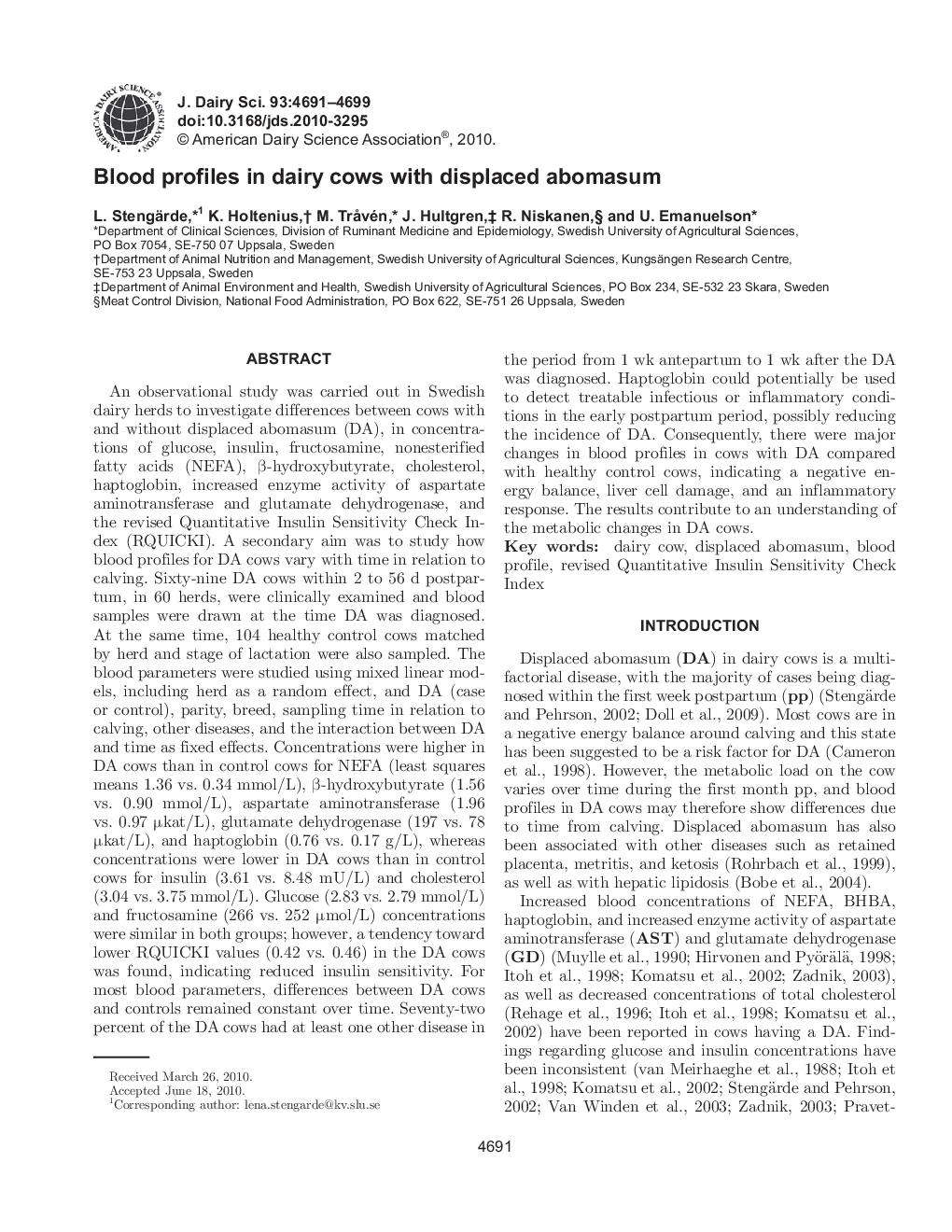| کد مقاله | کد نشریه | سال انتشار | مقاله انگلیسی | نسخه تمام متن |
|---|---|---|---|---|
| 5789878 | 1108092 | 2010 | 9 صفحه PDF | دانلود رایگان |
عنوان انگلیسی مقاله ISI
Blood profiles in dairy cows with displaced abomasum
دانلود مقاله + سفارش ترجمه
دانلود مقاله ISI انگلیسی
رایگان برای ایرانیان
موضوعات مرتبط
علوم زیستی و بیوفناوری
علوم کشاورزی و بیولوژیک
علوم دامی و جانورشناسی
پیش نمایش صفحه اول مقاله

چکیده انگلیسی
An observational study was carried out in Swedish dairy herds to investigate differences between cows with and without displaced abomasum (DA), in concentrations of glucose, insulin, fructosamine, nonesterified fatty acids (NEFA), β-hydroxybutyrate, cholesterol, haptoglobin, increased enzyme activity of aspartate aminotransferase and glutamate dehydrogenase, and the revised Quantitative Insulin Sensitivity Check Index (RQUICKI). A secondary aim was to study how blood profiles for DA cows vary with time in relation to calving. Sixty-nine DA cows within 2 to 56 d postpartum, in 60 herds, were clinically examined and blood samples were drawn at the time DA was diagnosed. At the same time, 104 healthy control cows matched by herd and stage of lactation were also sampled. The blood parameters were studied using mixed linear models, including herd as a random effect, and DA (case or control), parity, breed, sampling time in relation to calving, other diseases, and the interaction between DA and time as fixed effects. Concentrations were higher in DA cows than in control cows for NEFA (least squares means 1.36 vs. 0.34 mmol/L), β-hydroxybutyrate (1.56 vs. 0.90 mmol/L), aspartate aminotransferase (1.96 vs. 0.97 μkat/L), glutamate dehydrogenase (197 vs. 78 μkat/L), and haptoglobin (0.76 vs. 0.17 g/L), whereas concentrations were lower in DA cows than in control cows for insulin (3.61 vs. 8.48 mU/L) and cholesterol (3.04 vs. 3.75 mmol/L). Glucose (2.83 vs. 2.79 mmol/L) and fructosamine (266 vs. 252 μmol/L) concentrations were similar in both groups; however, a tendency toward lower RQUICKI values (0.42 vs. 0.46) in the DA cows was found, indicating reduced insulin sensitivity. For most blood parameters, differences between DA cows and controls remained constant over time. Seventy-two percent of the DA cows had at least one other disease in the period from 1 wk antepartum to 1 wk after the DA was diagnosed. Haptoglobin could potentially be used to detect treatable infectious or inflammatory conditions in the early postpartum period, possibly reducing the incidence of DA. Consequently, there were major changes in blood profiles in cows with DA compared with healthy control cows, indicating a negative energy balance, liver cell damage, and an inflammatory response. The results contribute to an understanding of the metabolic changes in DA cows.
ناشر
Database: Elsevier - ScienceDirect (ساینس دایرکت)
Journal: Journal of Dairy Science - Volume 93, Issue 10, October 2010, Pages 4691-4699
Journal: Journal of Dairy Science - Volume 93, Issue 10, October 2010, Pages 4691-4699
نویسندگان
L. Stengärde, K. Holtenius, M. TrÃ¥vén, J. Hultgren, R. Niskanen, U. Emanuelson,